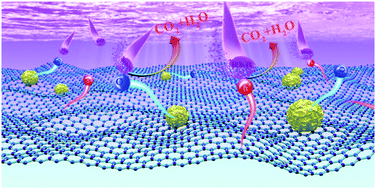Electrostatic interaction assisted synthesis of a CdS/BCN heterostructure with enhanced photocatalytic effects†
Abstract
In this manuscript, a novel photocatalyst, CdS/BCN composites with CdS nanoparticles in situ grown on BCN nanosheets (CdS/BCN), was synthesized via a simple electrostatic interaction assisted supersaturated recrystallization method. Benefiting from a unique heterostructure, the CdS/BCN composites exhibited highly efficient and stable photocatalytic activity for degrading RhB and methylene blue under visible-light irradiation, and moreover, a high rate constant of 0.115 min−1 has been obtained for degrading RhB, which was much higher than that of most CdS based photocatalysts (0.089 min−1). First-principles calculations revealed that the significantly enhanced photocatalytic activity of the CdS/BCN composite was mainly ascribed to the formed type-II heterojunction and the built-in electric field at the interface between CdS nanoparticles and BCN nanosheets, which promote the transfer of photo-generated electrons between CdS and BCN, and the ˙O2− radical originating from enriched photo-generated electrons was found to be the dominant species that was responsible for the enhanced photocatalytic performance in degrading organic molecules.



 Please wait while we load your content...
Please wait while we load your content...